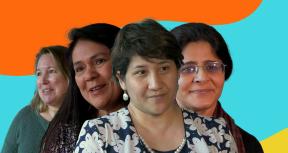TWEET THIS
Without developing solutions for tackling financial viability and cross-sectoral impacts head-on, credible progress towards SDG 6 is unlikely.
Despite progress made in the last twenty years, about 600 million people worldwide still lack access to safe drinking water, and 2.4 billion do not have adequate sanitation. This access gap is concentrated in low-income and lower middle-income countries and among the urban and rural poor, especially in Sub-Saharan Africa, South Asia, and East Asia. Countries in these regions have an uphill task in bridging the access gap in the face of growing populations and increasing rural to urban migration.
As part of the sustainable development goals, world leaders have committed to “ensure access to water and sanitation for all” by 2030 (SDG 6). The goal raises the bar from merely providing a connection or access, to providing universal service delivery that is equitable, adequate, and reliable.
A new report released by the Independent Evaluation Group, A Thirst for Change: An Evaluation of the World Bank Group’s Support for Water Supply and Sanitation with Focus in the Poor, assessed the World Bank Group’s effectiveness and readiness in supporting client countries to achieve universal access to water and sanitation (SDG 6).
The Challenges, and the Way Forward

- Lack of financial viability and accountability of service providers are at the core of the water supply and sanitation service gaps and disparities, and the Bank’s response in this respect has been inadequate. Only 4 percent of the Bank’s projects in this sector declared financial viability as an explicit objective. While 71 percent of evaluated projects report moderately satisfactory or better development outcomes, over 40 percent of these projects face significant or high risk to their outcomes, mainly due to lack of financial viability, diluting the impact of the nearly $30 billion of World Bank Group’s finance for the sector during 2007-16. IEG’s evaluation recommends that the Bank group aligns its results frameworks and key performance indicators with the sustainable development goals (SDG 6), and that the evidence base is developed to track accountability for water and sanitation service delivery.
- The water and sanitation service sector faces cross-sectoral challenges that are approaching crisis proportions in many areas, but the World Bank Group has not developed yet a systematic response to address such challenges. Competing demand for water resources from agriculture and industry, climate change, pollution of water bodies (which are the very source of water supply) from untreated wastewater, and poorly managed solid waste and industrial effluents, present a formidable set of interrelated development challenges. With a few exceptions, IEG found that the Bank Group is not sufficiently coordinating internal efforts to address these issues, or to support client governments to deal with them in a systematic manner. IEG recommends greater collaboration between units within the Bank Group to address complex water and sanitation service-related challenges, and increase engagement with countries to foster similar collaboration between their policy-making bodies.
- Securing financial viability and institutional accountability of service providers is crucial to attract much needed investments into the water and sanitation service sector, including private sector finance. Of the $30 billion of World Bank Group support for this sector during 2007-16, IFC and MIGA account for only 5 percent and 2 percent, respectively. Meeting the SDG 6 targets requires an unprecedented increase in investments (three times current levels) to bridge the current gaps in access and service delivery. This presents a formidable challenge for the successful application of the Cascade Approach to this sector. IEG recommends support for strengthening the financial viability of service providers, and creating conditions for commercial finance in keeping with the Cascade Approach.
An Opportunity to Build on Successes
IEG’s evaluation also highlights pioneering and successful initiatives by the Bank in the water and sanitation service sector in several countries. The challenge is to replicate these positive experiences elsewhere. Bank projects in Brazil and Morocco have helped improve utility performance and accountability, and facilitated private sector participation in Colombia. Community-based rural water and sanitation services has been mainstreamed in several countries with positive results, and decentralized cell phone-based monitoring and evaluation (M&E) systems in Indonesia have promoted service provider accountability. Bank projects have helped Mexico and Brazil deal with extreme water stress situations and are helping Argentina, Egypt and India with reducing the impact of wastewater on water bodies.
In sum, without developing solutions for tackling financial viability and cross-sectoral impacts head-on, credible progress towards SDG 6 is unlikely. To effectively support client countries in moving towards SDG 6, the Bank Group must help develop solutions to the issues of financial viability, institutional accountability and cross-sectoral impacts. Currently, there are no sustainable models for addressing these issues in fast developing low-income and low middle-income countries.









Comments
Access to safe drinking…
Access to safe drinking water is indeed a major development challenge because of the role water play in man. Poor drinking water have the ability to offset efforts in SDG's such as health goals, zero poverty and No hunger in rural areas. During a water project feasibility study in four villages in Cameroon, i discovered that, all the villages indicated poor health as their problem and the need for a health facility is the most pressing need for them. However, the study revealed that, lack safe drinking water is the main cause of poor health and a driver for poverty in that area . Despite huge donor interest in provision of safe drinking water, CSO's in Cameroon are still limited in providing water and sanitation services because of limited finances. In a pilot evaluation readiness assessment for civil society in Cameroon. I equally discovered that, CSO's have very little M$E capacity to account for expenditure and report outcomes of their interventions and as such can not secure much funds . This is inline with Ramachandra Jammi article above.
Add new comment